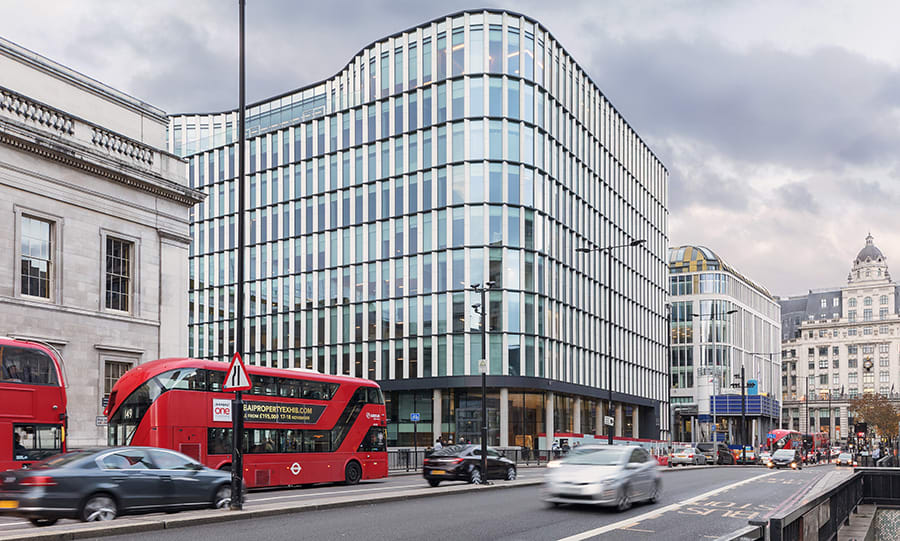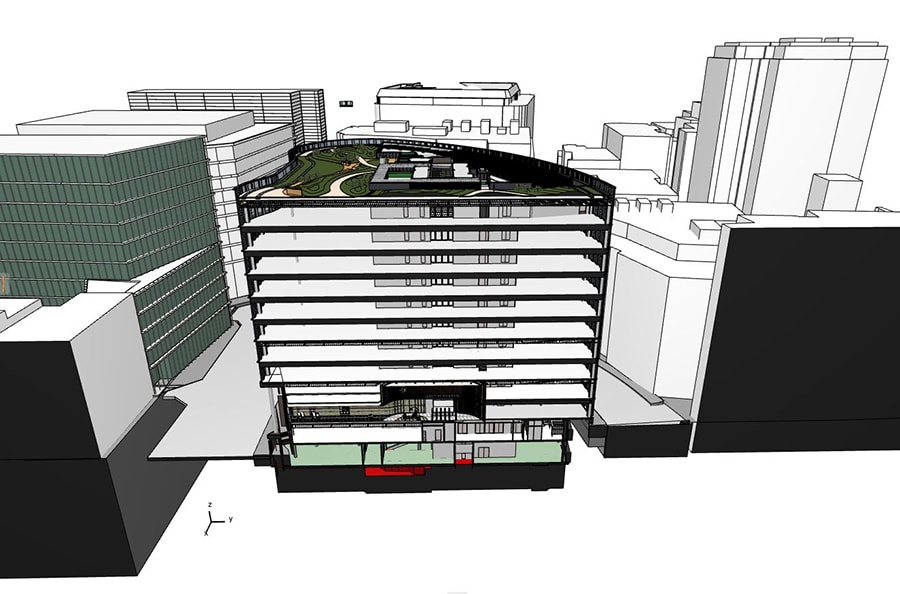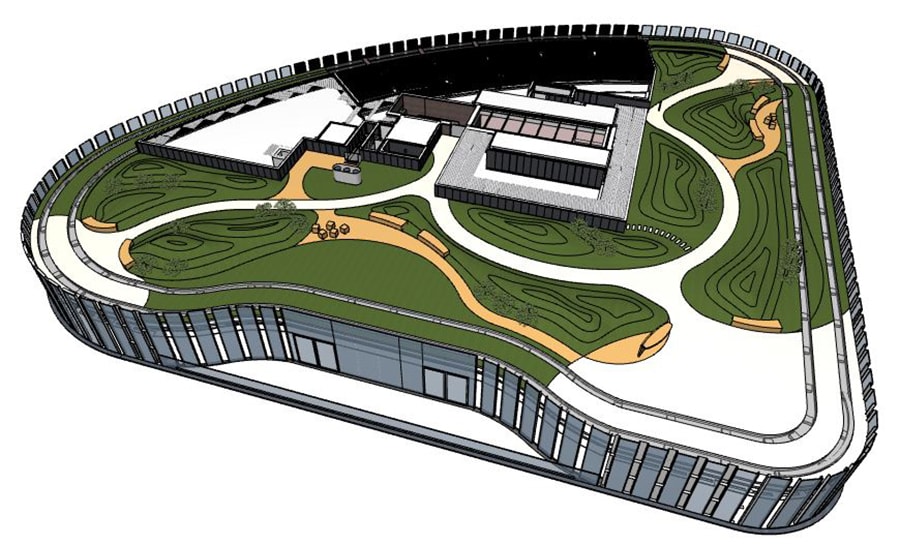33 Central is a striking building at the gateway to the City of London. Topped with one of the City’s largest roof gardens, and achieving a BREAAM Excellent rating, the building not only offers a flexible modern office space but is also a fine example of sustainable design and construction.
John Robertson Architects (JRA) managed the project over a 10-year period, through feasibility studies and planning consent, to detailed design and overseeing construction.
The original building at 33 King William Street was constructed in the 1980s. In 2008 the then owner, property and investment group Topland, asked JRA to undertake a feasibility study to refurbish the existing building. However, following this study, the decision was taken to demolish and re-build.
The new building was designed to maximise the letting area and also to attract potential buyers. As a result, JRA managed to increase the lettable space by 65% from the original building despite the new structure having fewer floors. Meanwhile, the vast landscaped roof garden crowning the building offers unobstructed views to the City of London, Canary Wharf and the River Thames.
A sustainable plan
In 2013, Topland sold the site to international property developer HB Reavis, which in turn appointed JRA to develop a detailed user-focused design for the site and deliver the new building.
Sustainability was very important for HB Reavis and after reviewing the plans asked JRA to increase the area of the roof garden. Photovoltaic arrays which were to be installed on the roof were reduced in size, allowing JRA to increase the landscaped roof area by 30% to provide planting space for 9,000 plants from more than 55 native species.

33 Central sits at the gateway to the City of London
To accommodate the roof garden, most of the building’s heating, ventilation, and air conditioning equipment and plant was relocated from the roof into the basement. A huge 12-storey watertight air shaft runs through the middle of the building into the basement to provide air intake.
A modern design in a conservation area
One of the key challenges was to create a modern building that worked contextually with the historically significant buildings that surround it.
33 Central is situated on a prominent site in the City of London at the northern approach to London Bridge. From the outset the building was conceived as a complementary backdrop to the Grade 2* listed Fishmonger’s Hall, which sits in front of it, and the art deco Adelaide House opposite.
Planners were keen for the architects to use traditional materials. Rather than smaller handmade tiles, JRA chose a bespoke large-scale terracotta faience for the exterior. The colours mirror and complement those of the surrounding buildings.
Agnieszka Szedzianis, associate at JRA, explains: “It was important to think about creating a timeless design, as the whole design, planning and build process can take many years and we needed the building to still be viewed as modern and contemporary when it was completed. Back in 2011, it was very innovative to push for a roof garden. There was no example of that in the City of London, and the planners were very impressed.”
Internally the building is planned around a central core that echoes the shape of the site. The wide, clear floor plates are suitable for a variety of different occupiers making the building flexible, as well as maximising the internal floor area. A deep 18-metre wide area is ideal for trading floors, 15 metre deep areas are designed for meeting rooms and breakout spaces, and 12 metre spaces are perfect for individual offices. JRA also minimised the number of columns to maximise flexibility during internal fit-out.
Re-using existing foundations
To minimise disruption, costs, and environmental impact, JRA opted to re-use the building’s existing foundations. With no excavation needed, the project could be completed up to two years early. What’s more, 49% of the concrete used in the new building was recycled, which meant fewer materials needed to be transported into the centre of London.

The team used elements of BIM Level 1 and Level 2 during the design and coordination processes
“We knew the shape of the existing foundations from the previous drawings, but after the original building was demolished, we found they were weaker than we had thought,” says Agnieszka. “Consequently, the new building has a lightweight steel structure, chosen so that it could sit on the existing foundations.”
JRA estimates that 24km of steel section was used in the building. The design delivers 2.75m floor to ceiling space, with a facade ratio of 1:2 solid to glass with full-height glazing (5,000 panels each weighing up to 53kg) on each elevation for the offices. This maximises the natural light inside, improves thermal insulation and reduces energy costs.
A team approach
JRA produced the initial designs in ArchiCAD 10, and then re-drew the model in ArchiCAD 15, 17 and 19 as the years progressed, to benefit from the latest functionality in the software.
Agnieszka says: “We had a team of up to 15 people working on the project across two countries at any one time. We designed in 3D using ArchiCAD, and with BIMServer and a fast internet connection, this was a smooth process.
“We use Graphisoft’s Teamwork on every project within our practice and we find it invaluable. At one point, we had some members of the team working on the technical drawings, some working on renders and modelling, and others checking details with the contractors.”
The best tools for the job
JRA used ArchiCAD’s trace reference tool extensively on the project. “It allowed us to compare the new model with old versions and check everything aligned and coordinated correctly,” says Agnieszka. “The tool also enabled us to add two different contractor drawings to the model and to immediately see the different versions and what had changed.
“In addition, we used Profile Manager to model structure encasements and facade elements. Core and repetitive elements of details were drawn in separate files and imported as hotlinks or modules.”

In 2011, it was very innovative to push for a roof garden
Agnieszka and her team coordinated and exchanged information with six different companies during the project.
“The scheduling tool helped the quantity surveyor to calculate the volumes of materials needed and we imported IFC models from the structural engineers to check the steel frame and to coordinate with architectural elements.”
Starting in 2011, the project wasn’t run to BIM level 2. However, the team used elements of BIM Level 1 and Level 2 during the design and coordination processes.
“In particular, designing in 3D helped to coordinate with the structural engineer and the MEP. The 3D models also showed the complex junctions and movement joints and helped to inform how to construct and fire protect the building,” says Agnieszka.
“The clients liked working in 3D and enjoyed having the ability to move around the model in 3D during design meetings. And by showing the client the ArchiCAD model during design meetings we had the flexibility to change things straight away.”
JRA was appointed by HB Reavis during the build stage and was heavily involved during the construction process.
“We monitored progress on site and also helped the developer with the detailing and interface details between the different trades,” says Agnieszka. “We provided information in both 3D and 2D including scale drawings of the model, which were produced directly from ArchiCAD. We also imported all drawings from the contractors into our model to compare with their proposals.”
Award-winning building
Purchased by US bank Wells Fargo to establish its headquarters in London, the completed building offers 225,000 sq ft of light-filled prime office space, with river views and a beautiful roof garden. It achieved a BREEAM Excellent rating and has substantial cycle facilities which exceed the London Plan requirements, including cycle racks and showers to encourage people to cycle or run to work or during their lunch break. As a result, the building was awarded a platinum cycling certificate score.
In addition, the project won Graphisoft’s Project of the Year 2018, was shortlisted for the AJ100 2018 Sustainable Practice of the Year award, shortlisted for the New London Architecture 2018 offices category, was highly commended in the Property Awards 2018 Developer of the Year category and was a finalist in the British Council for Offices 2018 Commercial Workplace category.















